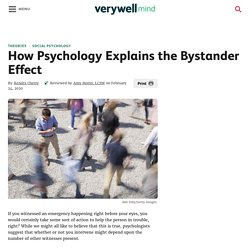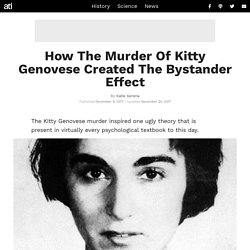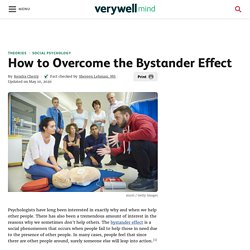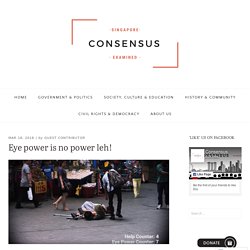

This is because of the bystander effect where it has occurred in public areas too many times. In this resource center, I will introduce this social psychological theory, to have a better understanding of the bystander effect, and also give methods on how to counteract this effect.
Description of the Introduction section.
What Is the Bystander Effect?
What Is the Bystander Effect?
If you witnessed an emergency happening right before your eyes, you would certainly take some sort of action to help the person in trouble, right?

While we might all like to believe that this is true, psychologists suggest that whether or not you intervene might depend upon the number of other witnesses present. How the Bystander Effect was discovered. How The Murder Of Kitty Genovese Created The Bystander Effect. Wikimedia CommonsKitty Genovese whose muder would inspire the psychological phenomenon known as the bystander effect.

At approximately 3:15 a.m. on March 13, 1964, a woman was murdered. Her name was Kitty Genovese. She was 28 years old, “self-assured beyond her years,” and had a “sunny disposition.” However, on that Friday evening, none of that mattered. As Kitty Genovese was stabbed to death in an alleyway outside her home, the friends and neighbors she had lived next to for several years stood by, choosing not to get involved as she lay there dying. Around 2:30 a.m. on the night of her attack, Kitty Genovese left the bar she worked at and headed for home. A few minutes after she left, she stopped at a traffic light. At 3:15, Genovese pulled into the parking lot of the Kew Gardens Long Island Rail Road station parking lot, which was about 100 feet from her front door. Getty ImagesKitty at work at Ev’s bar. Upon being stabbed, Genovese screamed, running toward her home.
Chapter 5: Experimental Research – Research Methods in Psychology. In the late 1960s social psychologists John Darley and Bibb Latané proposed a counter-intuitive hypothesis.

The more witnesses there are to an accident or a crime, the less likely any of them is to help the victim (Darley & Latané, 1968). They also suggested the theory that this phenomenon occurs because each witness feels less responsible for helping—a process referred to as the “diffusion of responsibility.” Darley and Latané noted that their ideas were consistent with many real-world cases. For example, a New York woman named Catherine “Kitty” Genovese was assaulted and murdered while several witnesses evidently failed to help. But Darley and Latané also understood that such isolated cases did not provide convincing evidence for their hypothesized “bystander effect.” So to test their hypothesis, Darley and Latané created a simulated emergency situation in a laboratory. In actuality, there were no other students. The Parable of the 38 Witnesses. What are the causes of the Bystander Effect? How Diffusion of Responsibility Affects Group Behavior.
Diffusion of responsibility is a psychological phenomenon in which people are less likely to take action when in the presence of a large group of people.1 For example, imagine that you are in a large city on a bustling street.

You notice a man fall to the ground and start convulsing as if having a seizure. Many people turn and look at the man, but no one moves to help or call for medical assistance. Social Experiment: Diffusion of Responsibility. Pluralistic Ignorance (SOCIAL PSYCHOLOGY) - iResearchNet. Pluralistic Ignorance Definition Pluralistic ignorance occurs when people erroneously infer that they feel differently from their peers, even though they are behaving similarly.

As one example, imagine the following scenario: You are sitting in a large lecture hall listening to an especially complicated lecture. After many minutes of incomprehensible material, the lecturer pauses and asks if there are any questions. No hands go up. You look around the room. Another case of pluralistic ignorance that is familiar to many college students concerns drinking on campus.
PLURALISTIC IGNORANCE. Overcoming the Bystander Effect. How to Overcome the Bystander Effect. Psychologists have long been interested in exactly why and when we help other people.

There has also been a tremendous amount of interest in the reasons why we sometimes don't help others. The bystander effect is a social phenomenon that occurs when people fail to help those in need due to the presence of other people. In many cases, people feel that since there are other people around, surely someone else will leap into action.1 While the bystander effect can have a negative impact on prosocial behavior, altruism and heroism, researchers have identified a number of different factors that can help people overcome this tendency and increase the likelihood that they will engage in helping behaviors.2 Some of these include: Witnessing Helping Behavior Sometimes just seeing other people doing something kind or helpful makes us more willing to help others.
Imagine that you are walking into a large department store. Being Observant Being Skilled and Knowledgeable Guilt Feeling Good. Show Up: A Guide to Bystander Intervention. Eye power is no power leh! – Consensus. By Lynn Chia ‘Eye power’, as quintessentially Singaporean as it sounds, is really not just a Singaporean thing.

A local social experiment produced in 2014 on the passive bystander effect was one of the first local experiments that shed light on the importance of the diffusion of responsibility. In the social experiment, when the injured actor and the blind actor collided in an accident, many people exercised their ‘eye power’ by standing by without helping despite having witnessed the incident. See also: this Reddit thread Some people attribute this to the mind-your-own-business (MYOB) narrative that is seemingly perpetuated in our society. Why do we fail to act? This wasn’t an evil crowd that was glad someone had collapsed. Take another example, imagine that you are in Orchard Road. Singaporean Eye Power (feat. Steven Lim)